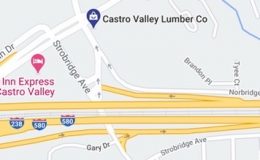The 1960 Castro Valley General Plan was truly visionary. Such documents usually are, but alas, they are rarely implemented. As one of my urban planning professors once remarked (with a nod to Alexander Pope): “To plan is human; to implement, divine.
1960 Castro Valley General Plan – What Might Have Been
- By : Michael Baldwin
- Category : Education, Featured Story, Local Control
So, what exactly is a “General Plan?” According to the Alameda County Planning Department, it is:
A General Plan is a long range policy document approved by the Board of Supervisors to guide physical, economic, and environmental growth. State law requires the County to have a General Plan which contains seven elements: Land Use; Circulation; Housing; Open Space; Conservation; Safety and Noise. The plan expresses the County’s vision for the future and is the roadmap for achieving the community’s desired quality of life. It is an assessment of current and future needs, and the resources needed to implement the goals and policies established. As the needs of the County change, the Planning Department with citizen comment and input makes recommendations to the Board of Supervisors to reflect the direction for the future and to update the General Plan.
The Castro Valley General Plan was last updated in 2010, and it is a very detailed plan. It took over seven years of community meetings an input to craft the plan meant to guide our development for the next 20 years. It was not, however the first attempt at creating a plan and vision for the future of our town. Looking back at “what might have been” can be an enlightening experience. Most incorporated cities have ongoing reviews of their General Plans, and institute “course corrections” as neceessary. As an Unincorporated Area, we miss out on that, and Castro Valley is left to drift on the whims of the current Supervisor and elected CVUSD Board members.
Let’s review our grand plans of 1960.
The original Castro Valley General Plan was written in 1960, and formally adopted by the BOS on February 27, 1961. It generally made projections about what the town would be like and need in 1980. At the time, the population of Castro Valley was 38,700, and the report predicted a 1980 population of as many as 76,000. Two things that the plan reviewed in great detail were the schools, and public facilities.

Lets look at the grand plans envisioned for our Schools. At the time, there were 19 schools in the planning area serving approximately 9,900 students.
- Castro Valley School District had Sydney, Clifton, Parsons, Chabot, Stanton, Norbridge, Proctor, Redwood, Marshall, Vannoy and Castro Valley Elementary Schools, and A.B. Morris and Earl Warren Jr. High Schools
- Independent Elementary was part of the Independent School District
- San Lorenzo School District had Fairmont Terrace and El Portal Elementary Schools
- Hayward Elementary School District had Laurel and Baywood Elementary Schools, and Strobridge Jr. High
- Castro Valley High School belonged to the Hayward Union High School District (and would remain there until the District was dissolved in 1963).

The plan projected student enrollment to exceed 20,000 by 1980 and called for increasing the school count to 29 by adding ten new schools to the area including:
- Two new K-3 schools located West of Redwood Rd, and North of the High School
- One new K-3 school located West of Castro Valley Elementary
- One new K-6 Elementary School near Earl Warren Jr. High (now Creekside MS)
- Two new K-6 Elementary Schools, one in Cull Canyon and one in Crow Canyon
- One new K-6 Elementary School West of Redwood Rd, and just South of Grove Way.
- Two new Jr High Schools, one North of Stanton Elementary and one where Canyon MS now stands
- One new High School near the intersection of Castro Valley Blvd and Crow Canyon Road
Additionally, the plan called for a new Junior College to be built on Lake Chabot Road, using land from the former Nike missile site.
In actuality, Castro Valley enrollment went into a steep decline eventually bottoming out in the mid-1980’s at around 4400 students. In 2014, we now have 13 conventional schools within the General Plan Area serving approximately 9500 students:
- Nine Elementary, two Middle and one High School in CVUSD
- One Elementary School in HUSD
Many of our school facilities from 1960 have been put to other uses:
- Baywood, Sydney and Parsons Elementary schools as well as A.B. Morris Jr. High were all closed and the land redeveloped into new housing.
- Norbridge Elementary was closed and sold to the BART district as part of the new Castro Valley station
- Laurel, El Portal and Fairmont Terrace Elementary schools were closed, but the sites have been leased to private schools
- Strobridge Jr. High was converted to an Elementary School
- Canyon High School was built, but converted to a middle school in the 1970’s
- Earl Warren Jr. High was closed in the 1970’s, but reopened in 1996 as Creekside Middle School
- Clifton Elementary was closed, but reopened as Redwood Continuation High School
- Redwood Elementary was closed, but reopened and the site is now used as Alma Preschool, the Castro Valley Adult School and the CVUSD District Office.

The plan also called for a nine acre “Cultural Civic Center” to be built. The new library on Redwood Rd was to be the first building built in this complex planned to fill the West side of Redwood Road from Jamison Way to Lorena Avenue. A “Cultural Complex” would occupy the Northern end of the center and include the library, a small museum/art gallery, a YMCA or Boys Club, and meeting halls for Fraternal Groups. The Southern end of the Center would contain a branch government administration building (or city hall,) a post office, chamber of commerce building, and rentable space for community groups such as the Red Cross and the Boy and Girl Scouts. There was also to be a 20 acre park adjacent to the site, “or in the general vicinity.”

As the plan stated “…regardless of whether the area incorporates, annexes or remains unincorporated, a local administration building should be located in the Cultural-Civic Center to assist in serving the 1980 community of 72,000 persons.”
54 years later in 2014, we can see the only thing to come of that grand proposal is the now vacant library building.
According to the Alameda County Community Development Agency, the next County plan up for rewrite is the long neglected and woefully out of date 1993 Castro Valley Downtown Specific Plan -although this rewrite has not yet started, and funding has not yet been allocated. Considering the last rewrite of our General Plan took over seven years to complete, we may not see the Downtown Specific Plan revised until 2020. Looking back at what “might have been” if we had stuck to, and regularly revised our 1960 plan should inspire the County to review and revise all of their General and Specific Plans on a more frequent and reliable cycles.


